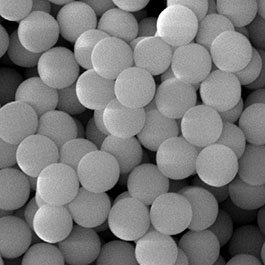Glantreo synthesise silica. We identified a gap in the market, monodispersed silica without classification.
1. Highly monodispersed without the need to size classify leading to high chromatographic efficiency
2. Monodensity leading to higher packing stability as there are no macro pores within the particles.
The foundation of any good chromatography column is the stationary phase. We are experts in stationary phases.
SOLAD™ is a proprietary process for manufacture of non porous silica particle for use in HPLC and UHPLC.
Whilst having a low surface area due to the lack of porosity, these particles nonetheless have a high efficiency due to their ultra high monodisperse nature and their favourable surface chemistry. Combining this superior stationary phase with Glantreo’s capability from a binding and packing perspective produces a world-class column.
Available in a range of particle sizes and chemistries. The SOLAD Protein A is a novel affinity HPLC column, based on the next-gen SOLAD platform technology, for quick separation and robust quantification of various antibodies. It provides rapid, accurate titre analysis with linearity across a wide concentration range, without any carryover. See below Technical Data Sheet for more details.
| Particle Size | 1.9um, 5um (Protein-A) & 10um (Protein-A) (others upon request) |
| Chemistry | C18, C8, C4, Silica, Protein-A (others upon request) |
| Column Hardware | 2.1x150, 2.1x250, 2.1x50, 2.1x100, 3.0x100, 3.0x150, 3.0x250, 3.0x50, 4.6x100, 4.6x150, 4.6x250, 4.6x50 See TDS for Protein-A Column Hardware Options. |
If you have published and cited Glantreo’s materials then click here to let us know.
Benjamin A. Ashu-Arraha, Jeremy D. Glennona,∗, Klaus Albertb, Synthesis and characterisation of bonded mercaptopropyl silica intermediate stationary phases prepared using multifunctional alkoxysilanes in supercritical carbon dioxide as a reaction solvent, Journal of Chromatography A, 1222 (2012) 38–45n
Maressa D. Dolzana,b, Daniel A. Spudeita,b, Zachary S. Breitbacha, William E. Barberc, Gustavo A. Mickeb, Daniel W. Armstronga,d, Comparison of superficially porous and fully porous silica supports used for a cyclofructan 6 hydrophilic interaction liquid chromatographic stationary phase, Journal of Chromatography A, 1365 (2014) 124-30
Szabolcs Feketea,∗, Erzsébet Oláhb, Jeno ̋Feketea, Fast liquid chromatography: The domination of core–shell and very fine particles, Journal of Chromatography A, 1228 (2012) 57–71
Víctor González-Ruiz, Ana I. Olives, M. Antonia Martín, Core-shell particles lead the way to renewing high-performance liquid chromatography, Trends in Analytical Chemistry (2014),
Victor K. Langsi, Benjamin A. Ashu-Arrah, Jeremy D. Glennon, Sub-2-m seeded growth mesoporous thin shell particles for high-performance liquid chromatography: Synthesis, functionalisation and characterisation, Journal of Chromatography A, 1402 (2015) 17–26
Lucie Nováková *, Lucie Havlíková, Hana Vlcˇková, Hydrophilic interaction chromatography of polar and ionizable compounds by UHPLC, Trends in Analytical Chemistry 63 (2014) 55–64
Jesse O. Omamogho, John P. Hanrahan, Joe Tobin, Jeremy D. Glennon, Structural variation of solid core and thickness of porous shell of 1.7µm core–shell silica particles on chromatographic performance: Narrow bore columns, Journal of Chromatography A, Volume 1218, Issue 15, 15 April 2011, Pages 1942-1953, ISSN 0021-9673 http://www.sciencedirect.com/science/article/pii/S0021967310016559
Jesse O. Omamoghoa, John P. Hanrahanb, Joe Tobinb, Jeremy D. Glennon, Structural variation of solid core and thickness of porous shell of 1.7 m core–shell silica particles on chromatographic performance: Narrow bore columns, Journal of Chromatography A, 1218 (2011) 1942–1953
Daniel A. Spudeita,b, Maressa D. Dolzana,b, Zachary S. Breitbacha, William E. Barberc, Gustavo A. Mickeb, Daniel W. Armstrong , Superficially porous particles vs. fully porous particles for bonded high performance liquid chromatographic chiral stationary phases: Isopropyl cyclofructan 6, Journal of Chromatography A, 1363 (2014) 89–95


